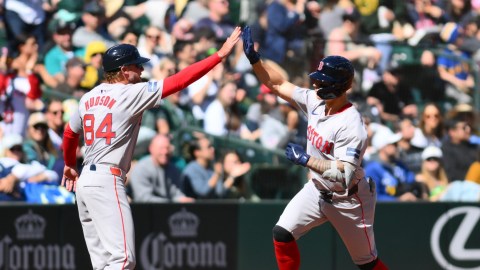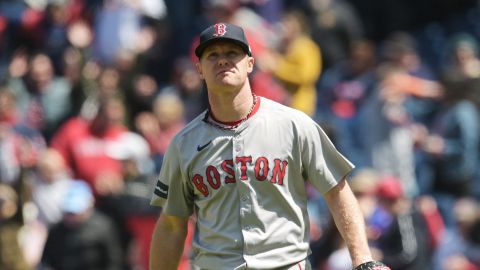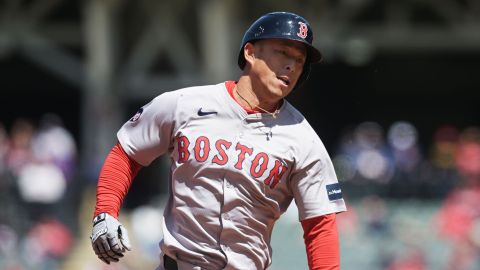Editor’s note: This story was published in December after the Boston Red Sox acquired Chris Sale from the Chicago White Sox. Sale makes his Red Sox debut Wednesday night against the Pittsburgh Pirates.
Offense should be hard to come by when you’re playing the Boston Red Sox in 2017.
The Red Sox on Tuesday acquired Chris Sale from the Chicago White Sox in a blockbuster trade that sets up Boston to have one of the best pitching staffs in baseball for the next two or three years — at least.
Boston already has 2012 Cy Young Award winner David Price and reigning Cy Young Award winner Rick Porcello, but Sale might be the best of the three.
Here’s what makes the left-handed ace so good:
THE ARSENAL
Fastball: Sale threw his fastball 59.2 percent of the time in 2016 (per FanGraphs). The velocity was down a tick in 2016 (more on that in a bit), but Sale still brings it. When he needs an extra few mph, he’s able to reach back and dial it up around 97 or 98 mph. Sale got hitters to swing and miss on 10.82 percent of his four-seam fastballs in 2016 and 6.94 percent of his “sinkers,” according to Brooks Baseball.
Slider: Sale used the slider a whopping 24.9 percent of the time in 2016, which isn’t entirely surprising. At its best, the pitch is unhittable for left-handed hitters. Right-handed hitters don’t fare much better, especially given its sharp, late break. Right-handed hitters have been known to swing at pitches that either hit their back leg or come close.
If you swing at the slider, you likely won’t hit it. Opposing hitters swung and missed at 35.5 percent of his sliders in 2016, which actually was down from 38.7 in 2015.
Changeup: Sale used his changeup just 15.7 percent of the time in 2016, down 12 percent from 2015, with an uptick in slider use. It’s kind of unfair, but Sale’s changeup can be just as effective as the fastball and slider and makes both of those pitches even better — he’s able to keep righties honest with the arm-side changeup on the outer half to set up the vicious slider/fastball combo. Sale’s whiff rate on changeups in 2016 was nearly 15 percent.
If you compared Sale’s swing-and-miss numbers from 2016 to the rest of his career, one thing stands out: the whiff rates are down across the board. As is velocity. But that was by design. Sale and White Sox pitching coach Don Cooper devised a plan to keep the pitcher fresh for the entire season.
“Listen, this wasn’t an easy decision going to the ‘hybrid,’ ” Cooper said of his plan in mid-September, per CSN Chicago. “You’re messing with one of the top guys in the game. If it don’t work, what the (heck) are you doing? What were you thinking about? But I kind of knew in my heart and my head that our biggest job is to keep him healthy and strong.”
The Red Sox would be smart to use a similar strategy.
THE MECHANICS
Here’s a slow-motion look at Sale’s windup.
Labeling Sale’s mechanics “unconventional” is an understatement.
He stays tall to start his windup, which is ideal, but things get different as he starts to plant his lead foot. Sale’s landing foot points toward the first base line, leaving him to throw across his body. That combined with a three-quarters arm angle allows Sale to get extra whip on the baseball.
Here are better looks at the release point:

Photo via Peter G. Aiken/USA TODAY Sports Images

Photo via Joe Nicholson/USA TODAY Sports Images
There was plenty of talk in 2016 about Price’s mechanics, but don’t expect similar conversations about Sale — assuming he stays healthy. The White Sox didn’t tinker with his mechanics at all after drafting him out of Florida Gulf Coast University, where he started using the lower release point, changing his career forever.
Some wonder whether Sale’s mechanics paired with his size will cause arm issues down the road. Cooper doesn’t expect that to happen.
From a (must-read) Bleacher Report story on Sale’s mechanics from 2015:
“Quacks,” White Sox pitching coach Don Cooper snarled. “I’ve devoted my life to mechanics. It’s something I’ve put a lot of time into. And I resent all of that: Is he going to be healthy? Is he going to stay healthy? Is he going to need Tommy John surgery?
“These are quacks. Show me your credentials.”
OTHER THOUGHTS
One of the biggest things you notice when watching Sale pitch is how uncomfortable he makes opposing hitters. There aren’t many — if any — pitchers who make batters more uncomfortable in the box.
Here he is, on the 118th pitch of his outing, getting two-time batting champion Jose Altuve to wave at a pitch:
And no one’s happier to see Sale in Boston than Pablo Sandoval.
It makes sense, too. He obviously has ridiculous stuff, and the unusual arm angle makes him lethal against righties and lefties alike, although it’s to the point where he rarely sees left-handed hitters.
Right-handed batters vs. Sale in 2016 (772 plate appearances): .232 batting average, .663 OPS, 191 K, 22 HR
Left-handed batters vs. Sale in 2016 (135 plate appearances): .197 batting average, .685 OPS, 42 K, 5 HR
Oh, and here’s the best Sale video on the internet.
FINAL THOUGHTS
Sale has been elite his entire big league career, and there’s no reason to believe that’s going to change anytime soon. That’s nothing groundbreaking, of course, as he’s widely (and correctly) considered one of baseball’s best pitchers.
Chris Sale all kinds of pumped up to pitch at Fenway Park >>
Thumbnail photo via Mark L. Baer/USA TODAY Sports Images




